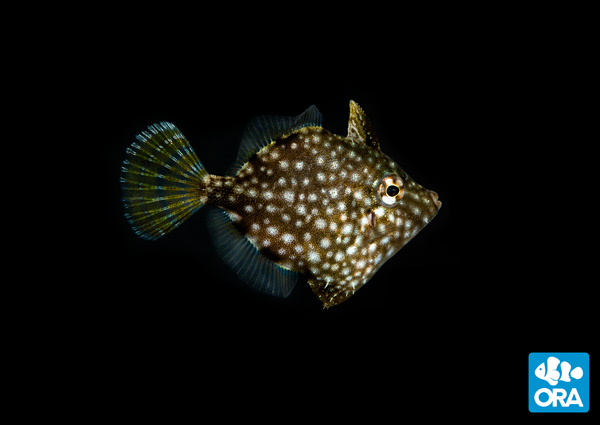Filefish are one of those forgotten groups in our hobby. Not generally thought of as reef safe, too timid for the typical fish-only setup (where their relatives, the Triggerfish, tend to be more obvious choices), the Filefish are relegated to the curiosities, the afterthoughts. ORA’s latest captive-breeding first, the Whitespotted Pygmy Filefish, aka. Rudarius ercodes, puts the filefish family at the forefront yet again.
Filefish have been one of those groups that breeders are able to chip away at, with Acreichthys tomentosus, the Bristletail (and Aiptasia-eating) Filefish, being the first known species successfully bred in captivity by Iris Bönig in 2007. I (Matt Pedersen), quickly followed up with the 2nd species, the Harlequin or Orange Spotted Filefish, Oxymonacanthus longirostris, in 2008. Both species are, in some senses of the terms, “moderately reef safe”, and perhaps are part of the reason that more people are looking at them these days.
Other breeders worked feverishly to add a third species, most notably perhaps being Dominick Cirigliano who successfully spawned, but failed to rear Rudarius ercodes despite good attempts. Cirigliano also at minimum spawned A. tomentosus again, as well as documenting what was probably the first spawn of a Pervagor species. During the time other breeders, including Andrew Berry and Chad Vossen (and undoubtedly others) were able to re-spawn O. longirostris as well, but no successful rearings were reported. I tried feverishly to break new ground, and in 2013 came close with documented spawnings of both the Red Sea Longnosed Filefish, Oxymonacanthus halli, and the Radial Filefish, A. radiatus, but neither resulted in successful rearing. I would not be surprised to learn of other attempts with other species.
And so it goes, after a bit of a dry spell on the filefish breeding front, ORA claims the newest captive-breeding first in the Monacanthid family with the tiny, and very agreeable Rudarius ercodes. ORA notes that despite this species “temperate” range, it has done perfectly fine at typical tropical temperatures. Additionally, in their estimation, this species is probably one we can consider “reef safe” as well.
The filefish in general have proven to be great breeding projects; being demersal spawners with tiny eggs that hatch as prolarvae, they come very close to being the equivalent of virtually all pelagic spawners, having tiny larvae that hatch out as prolarvae (no eyes, no gut, no mouth etc…). Some species even tend their nests, typically spawned in sand or patches of algae. It’s been far too long (6 years) since a Filefish was added to our list of captive-breeding accomplishments – BRAVO ORA!



